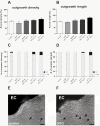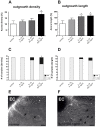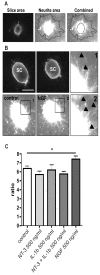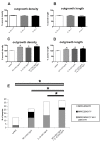Interleukin-1 beta and neurotrophin-3 synergistically promote neurite growth in vitro
- PMID: 22200088
- PMCID: PMC3275552
- DOI: 10.1186/1742-2094-8-183
Interleukin-1 beta and neurotrophin-3 synergistically promote neurite growth in vitro
Abstract
Pro-inflammatory cytokines such as interleukin-1 beta (IL-1β) are considered to exert detrimental effects during brain trauma and in neurodegenerative disorders. Consistently, it has been demonstrated that IL-1β suppresses neurotrophin-mediated neuronal cell survival rendering neurons vulnerable to degeneration. Since neurotrophins are also well known to strongly influence axonal plasticity, we investigated here whether IL-1β has a similar negative impact on neurite growth. We analyzed neurite density and length of organotypic brain and spinal cord slice cultures under the influence of the neurotrophins NGF, BDNF, NT-3 and NT-4. In brain slices, only NT-3 significantly promoted neurite density and length. Surprisingly, a similar increase of neurite growth was induced by IL-1β. Additionally, both factors increased the number of brain slices displaying maximal neurite growth. Furthermore, the co-administration of IL-1β and NT-3 significantly increased the number of brain slices displaying maximal neurite growth compared to single treatments. These data indicate that these two factors synergistically stimulate two distinct aspects of neurite outgrowth, namely neurite density and neurite length from acute organotypic brain slices.
Figures




Similar articles
-
Effects of proinflammatory cytokines on axonal outgrowth from adult rat lumbar dorsal root ganglia using a novel three-dimensional culture system.Spine J. 2015 Aug 1;15(8):1823-31. doi: 10.1016/j.spinee.2015.03.017. Epub 2015 Mar 20. Spine J. 2015. PMID: 25797812
-
Hypothermia-induced neurite outgrowth is mediated by tumor necrosis factor-alpha.Brain Pathol. 2010 Jul;20(4):771-9. doi: 10.1111/j.1750-3639.2009.00358.x. Epub 2010 Dec 8. Brain Pathol. 2010. PMID: 20070303 Free PMC article.
-
Proinflammatory Cytokines IL-1β and TNF-α Influence Human Annulus Cell Signaling Cues for Neurite Growth: In Vitro Coculture Studies.Spine (Phila Pa 1976). 2017 Oct 15;42(20):1529-1537. doi: 10.1097/BRS.0000000000002155. Spine (Phila Pa 1976). 2017. PMID: 28306638
-
Targeting Neurotrophins to Specific Populations of Neurons: NGF, BDNF, and NT-3 and Their Relevance for Treatment of Spinal Cord Injury.Int J Mol Sci. 2017 Mar 3;18(3):548. doi: 10.3390/ijms18030548. Int J Mol Sci. 2017. PMID: 28273811 Free PMC article. Review.
-
Nerve growth factor in the psychiatric brain.Riv Psichiatr. 2020 Jan-Feb;55(1):4-15. doi: 10.1708/3301.32713. Riv Psichiatr. 2020. PMID: 32051620 Review.
Cited by
-
Modified Citrus Pectin Alleviates Cerebral Ischemia/Reperfusion Injury by Inhibiting NLRP3 Inflammasome Activation via TLR4/NF-ĸB Signaling Pathway in Microglia.J Inflamm Res. 2022 Jun 9;15:3369-3385. doi: 10.2147/JIR.S366927. eCollection 2022. J Inflamm Res. 2022. PMID: 35706530 Free PMC article.
-
Polycistronic Delivery of IL-10 and NT-3 Promotes Oligodendrocyte Myelination and Functional Recovery in a Mouse Spinal Cord Injury Model.Tissue Eng Part A. 2020 Jun;26(11-12):672-682. doi: 10.1089/ten.TEA.2019.0321. Epub 2020 Feb 25. Tissue Eng Part A. 2020. PMID: 32000627 Free PMC article.
-
Unexpectedly High and Difficult-to-Explain Regenerative Capacity in an 82-Year-Old Patient with Insulin-Requiring Type 2 Diabetes and End-Stage Renal Disease.J Clin Med. 2025 Apr 8;14(8):2556. doi: 10.3390/jcm14082556. J Clin Med. 2025. PMID: 40283387 Free PMC article.
-
Dynamic control of proinflammatory cytokines Il-1β and Tnf-α by macrophages in zebrafish spinal cord regeneration.Nat Commun. 2018 Nov 7;9(1):4670. doi: 10.1038/s41467-018-07036-w. Nat Commun. 2018. PMID: 30405119 Free PMC article.
-
Absence of IL-1β positively affects neurological outcome, lesion development and axonal plasticity after spinal cord injury.J Neuroinflammation. 2013 Jan 14;10:6. doi: 10.1186/1742-2094-10-6. J Neuroinflammation. 2013. PMID: 23317037 Free PMC article.
References
-
- Bauer J, Berkenbosch F, Van Dam AM, Dijkstra CD. Demonstration of interleukin-1 beta in Lewis rat brain during experimental allergic encephalomyelitis by immunocytochemistry at the light and ultrastructural level. Journal of neuroimmunology. 1993;48(1):13–21. doi: 10.1016/0165-5728(93)90053-2. - DOI - PubMed
-
- Loddick SA, Rothwell NJ. Neuroprotective effects of human recombinant interleukin-1 receptor antagonist in focal cerebral ischaemia in the rat. J Cereb Blood Flow Metab. 1996;16(5):932–940. - PubMed
Publication types
MeSH terms
Substances
LinkOut - more resources
Full Text Sources
Research Materials

